The Aerospace Fluid Conveyance System Market is estimated to be valued at USD 3.1 billion in 2025 and is projected to reach USD 4.3 billion by 2035, registering a compound annual growth rate (CAGR) of 3.4% over the forecast period.
| Metric | Value |
|---|---|
| Aerospace Fluid Conveyance System Market Estimated Value in (2025 E) | USD 3.1 billion |
| Aerospace Fluid Conveyance System Market Forecast Value in (2035 F) | USD 4.3 billion |
| Forecast CAGR (2025 to 2035) | 3.4% |
The Aerospace Fluid Conveyance System market is experiencing steady growth, driven by the increasing demand for efficient fluid handling solutions across aircraft systems and components. Rising adoption is being supported by advancements in lightweight, high-strength materials and precision manufacturing techniques that enhance system reliability and reduce operational costs. The market is further shaped by growing air traffic, fleet expansion, and the need for advanced fluid conveyance solutions in both commercial and military aircraft.
Systems are being optimized to improve fuel efficiency, reduce maintenance downtime, and ensure operational safety. Regulatory standards and certification requirements for aerospace components are driving the adoption of high-quality, compliant systems that can handle extreme pressure, temperature, and vibration conditions.
Integration with modern aircraft systems, including hydraulic, fuel, and cooling networks, is increasing the demand for modular and flexible fluid conveyance solutions As aerospace manufacturers continue to prioritize performance, safety, and sustainability, the market is expected to witness sustained growth, with innovations in component design and materials driving efficiency and reliability across aircraft platforms.
The aerospace fluid conveyance system market is segmented by component, application, aircraft type, end-use, and geographic regions. By component, aerospace fluid conveyance system market is divided into Bellows, Joints, Tube Fittings, Couplings, Flanges, and Ducts. In terms of application, aerospace fluid conveyance system market is classified into Engine Conveyance System and Airframe Conveyance System. Based on aircraft type, aerospace fluid conveyance system market is segmented into Passenger Aircraft, Cargo Aircraft, Defence Aircraft, and Helicopters. By end-use, aerospace fluid conveyance system market is segmented into General Aviation, Civil Aviation, and Military Aircraft. Regionally, the aerospace fluid conveyance system industry is classified into North America, Latin America, Western Europe, Eastern Europe, Balkan & Baltic Countries, Russia & Belarus, Central Asia, East Asia, South Asia & Pacific, and the Middle East & Africa.
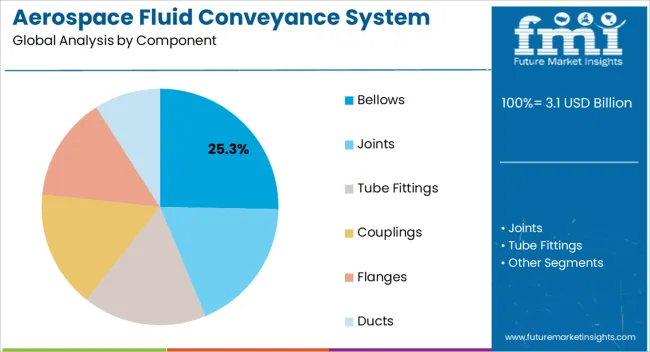
The bellows component segment is projected to hold 25.3% of the market revenue in 2025, establishing it as a leading component type. Its market prominence is driven by the ability to accommodate thermal expansion, vibration, and pressure fluctuations within aerospace fluid systems, ensuring reliable operation under extreme conditions. Bellows are being preferred due to their flexibility, durability, and precision performance in critical fluid conveyance applications such as fuel, hydraulic, and cooling systems.
The use of advanced alloys and high-performance materials has improved strength and corrosion resistance, enabling longer service life and reduced maintenance requirements. Integration with complex aircraft architectures allows bellows to provide modular and adaptable solutions that support safety and operational efficiency.
Growing demand from commercial aircraft manufacturers and system integrators, combined with stricter regulatory and certification standards, has reinforced adoption As aerospace systems continue to become more sophisticated, the bellows component is expected to maintain its market leadership, supported by technological advancements, material innovations, and increasing fleet expansions globally.
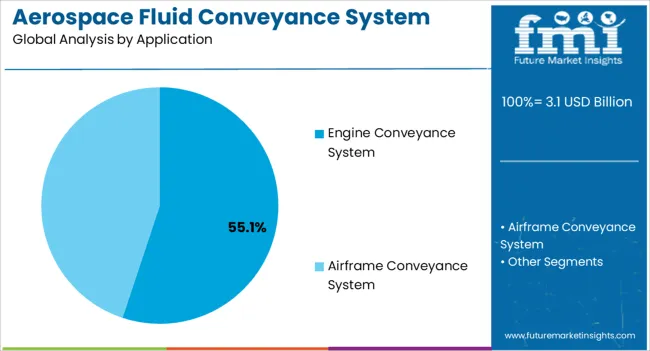
The engine conveyance system application segment is expected to account for 55.1% of the market revenue in 2025, making it the leading application area. Its growth is being driven by the critical need for efficient fluid transfer within engines, including fuel delivery, lubrication, and thermal management systems. Aerospace engines demand high-reliability conveyance solutions that can withstand high pressures, extreme temperatures, and continuous vibration during operation.
Integration of advanced materials and precision engineering ensures reduced leakage, enhanced performance, and improved safety. Investments in next-generation propulsion systems and fuel-efficient engine designs have further accelerated adoption. The ability to provide modular and lightweight solutions that contribute to overall aircraft efficiency is enhancing the appeal of these systems.
Compliance with stringent regulatory standards and certification requirements is reinforcing the preference for advanced engine fluid conveyance systems As aircraft engine technologies continue to evolve, the engine conveyance system application segment is expected to remain the primary driver of market growth, underpinned by innovation and operational performance requirements.
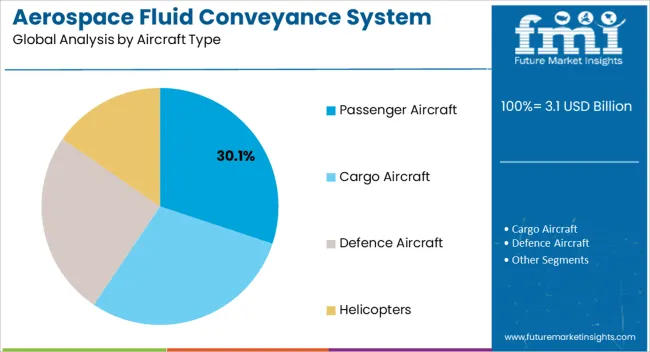
The passenger aircraft segment is projected to hold 30.1% of the market revenue in 2025, establishing it as the leading aircraft type. Growth in this segment is being driven by the continuous expansion of commercial air travel and fleet modernization initiatives by airlines worldwide. High reliability, safety, and efficiency requirements in passenger aircraft are driving the adoption of advanced fluid conveyance systems, which play a critical role in engine, hydraulic, fuel, and cooling applications.
Lightweight, modular components are being increasingly integrated to reduce aircraft weight, improve fuel efficiency, and ensure compliance with strict regulatory standards. Rising investments in passenger aircraft production, particularly in regions with growing air travel demand, are further supporting market expansion.
The integration of advanced materials, precision manufacturing, and real-time monitoring solutions is enhancing operational performance while reducing maintenance costs As airlines continue to prioritize performance, safety, and operational efficiency, the passenger aircraft segment is expected to maintain its market leadership, contributing significantly to overall aerospace fluid conveyance system demand.
A fluid conveyance system is made up of components that are used to transport critical gases and liquids throughout an aircraft. For both civil and military aviation, these are the key components that are controlling and managing the flow of fluids in low and high pressure and temperature sections of rotary winged and fixed winged aircraft.
The fluid conveyance system includes bellows, joints, tube fittings, couplings, flanges, and ducts, that are some of the most important components. Each component is placed in the appropriate location on the aircraft to carry out its vital function.
For instance, by application type the two main classifications for duct systems are high pressure and low pressure application. While low pressure ducts are used in low pressure and low temperature areas, such as the transition duct, cabin sidewall riser duct, windscreen demisting, flight deck air distribution, flight deck instrumentation cooling, avionics ventilation, cabin recirculation, and air conditioning supply, high pressure duct systems deploy components throughout the entire aircraft, from leading edges of the wings through the fuselage and engines.
Some of the key reasons that are propelling the growth of the market includes increasing urbanization and per capita income that has supported the Air transportation, especially in the developing nations. Apart from that increasing energy efficiency of a plane the demand for energy efficient components is also increasing, that is expected to fuel the market growth in during Assessment period.
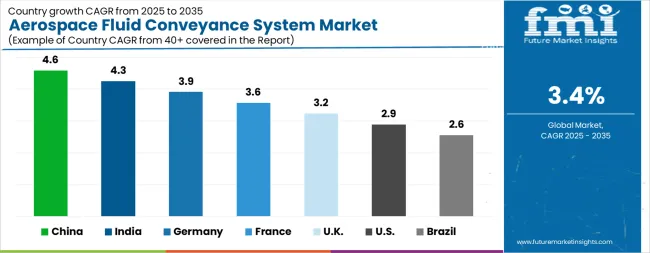
| Country | CAGR |
|---|---|
| China | 4.6% |
| India | 4.3% |
| Germany | 3.9% |
| France | 3.6% |
| UK | 3.2% |
| USA | 2.9% |
| Brazil | 2.6% |
The Aerospace Fluid Conveyance System Market is expected to register a CAGR of 3.4% during the forecast period, exhibiting varied country level momentum. China leads with the highest CAGR of 4.6%, followed by India at 4.3%. Developed markets such as Germany, France, and the UK continue to expand steadily, while the USA is likely to grow at consistent rates. Brazil posts the lowest CAGR at 2.6%, yet still underscores a broadly positive trajectory for the global Aerospace Fluid Conveyance System Market. In 2024, Germany held a dominant revenue in the Western Europe market and is expected to grow with a CAGR of 3.9%. The USA Aerospace Fluid Conveyance System Market is estimated to be valued at USD 1.1 billion in 2025 and is anticipated to reach a valuation of USD 1.5 billion by 2035. Sales are projected to rise at a CAGR of 2.9% over the forecast period between 2025 and 2035. While Japan and South Korea markets are estimated to be valued at USD 146.3 million and USD 92.2 million respectively in 2025.
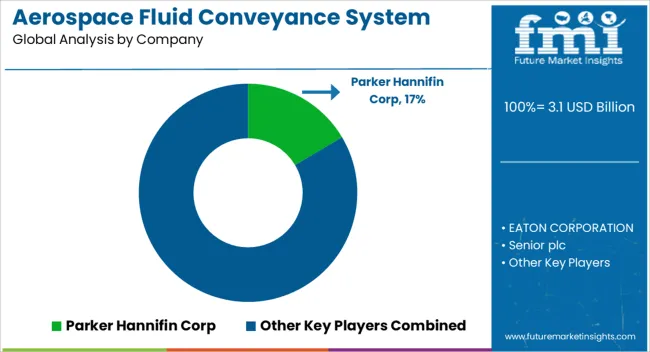
| Item | Value |
|---|---|
| Quantitative Units | USD 3.1 Billion |
| Component | Bellows, Joints, Tube Fittings, Couplings, Flanges, and Ducts |
| Application | Engine Conveyance System and Airframe Conveyance System |
| Aircraft Type | Passenger Aircraft, Cargo Aircraft, Defence Aircraft, and Helicopters |
| End-Use | General Aviation, Civil Aviation, and Military Aircraft |
| Regions Covered | North America, Europe, Asia-Pacific, Latin America, Middle East & Africa |
| Country Covered | United States, Canada, Germany, France, United Kingdom, China, Japan, India, Brazil, South Africa |
| Key Companies Profiled | Parker Hannifin Corp, EATON CORPORATION, Senior plc, Flexfab Horizons International, Inc., Unison, LLC, PFW Aerospace GmbH, Boing, Gulfstream Aerospace Corporation, Amcraft Manufacturing, Smiths Group Plc, Stelia Aerospace, and Textron Aviation Inc. |
The global aerospace fluid conveyance system market is estimated to be valued at USD 3.1 billion in 2025.
The market size for the aerospace fluid conveyance system market is projected to reach USD 4.3 billion by 2035.
The aerospace fluid conveyance system market is expected to grow at a 3.4% CAGR between 2025 and 2035.
The key product types in aerospace fluid conveyance system market are bellows, joints, tube fittings, couplings, flanges and ducts.
In terms of application, engine conveyance system segment to command 55.1% share in the aerospace fluid conveyance system market in 2025.






Our Research Products

The "Full Research Suite" delivers actionable market intel, deep dives on markets or technologies, so clients act faster, cut risk, and unlock growth.

The Leaderboard benchmarks and ranks top vendors, classifying them as Established Leaders, Leading Challengers, or Disruptors & Challengers.

Locates where complements amplify value and substitutes erode it, forecasting net impact by horizon

We deliver granular, decision-grade intel: market sizing, 5-year forecasts, pricing, adoption, usage, revenue, and operational KPIs—plus competitor tracking, regulation, and value chains—across 60 countries broadly.

Spot the shifts before they hit your P&L. We track inflection points, adoption curves, pricing moves, and ecosystem plays to show where demand is heading, why it is changing, and what to do next across high-growth markets and disruptive tech

Real-time reads of user behavior. We track shifting priorities, perceptions of today’s and next-gen services, and provider experience, then pace how fast tech moves from trial to adoption, blending buyer, consumer, and channel inputs with social signals (#WhySwitch, #UX).

Partner with our analyst team to build a custom report designed around your business priorities. From analysing market trends to assessing competitors or crafting bespoke datasets, we tailor insights to your needs.
Supplier Intelligence
Discovery & Profiling
Capacity & Footprint
Performance & Risk
Compliance & Governance
Commercial Readiness
Who Supplies Whom
Scorecards & Shortlists
Playbooks & Docs
Category Intelligence
Definition & Scope
Demand & Use Cases
Cost Drivers
Market Structure
Supply Chain Map
Trade & Policy
Operating Norms
Deliverables
Buyer Intelligence
Account Basics
Spend & Scope
Procurement Model
Vendor Requirements
Terms & Policies
Entry Strategy
Pain Points & Triggers
Outputs
Pricing Analysis
Benchmarks
Trends
Should-Cost
Indexation
Landed Cost
Commercial Terms
Deliverables
Brand Analysis
Positioning & Value Prop
Share & Presence
Customer Evidence
Go-to-Market
Digital & Reputation
Compliance & Trust
KPIs & Gaps
Outputs
Full Research Suite comprises of:
Market outlook & trends analysis
Interviews & case studies
Strategic recommendations
Vendor profiles & capabilities analysis
5-year forecasts
8 regions and 60+ country-level data splits
Market segment data splits
12 months of continuous data updates
DELIVERED AS:
PDF EXCEL ONLINE
Aerospace Fastener Manufacturing Solution Market Size and Share Forecast Outlook 2025 to 2035
Aerospace Adhesives and Sealants Market Size and Share Forecast Outlook 2025 to 2035
Aerospace Forging Materials Market Size and Share Forecast Outlook 2025 to 2035
Aerospace and Defense Cyber Security Market Size and Share Forecast Outlook 2025 to 2035
Aerospace Cold Forgings Market Size and Share Forecast Outlook 2025 to 2035
Aerospace Defense Ducting Market Size and Share Forecast Outlook 2025 to 2035
Aerospace Defense C Class Parts Market Size and Share Forecast Outlook 2025 to 2035
Aerospace Electrical Inserts Market Size and Share Forecast Outlook 2025 to 2035
Aerospace Foams Market Size and Share Forecast Outlook 2025 to 2035
Aerospace Robotics Market Size and Share Forecast Outlook 2025 to 2035
Aerospace Engineering Services Outsourcing (ESO) Market Analysis - Size, Share, and Forecast Outlook (025 to 2035
Aerospace DC-DC Converter Market Analysis - Size, Share, and Forecast Outlook 2025 to 2035
Aerospace Fastener Market Analysis Size Share and Forecast Outlook 2025 to 2035
Aerospace 3D Printing Materials Market Size and Share Forecast Outlook 2025 to 2035
Aerospace Radome Market Size and Share Forecast Outlook 2025 to 2035
Aerospace Interior Market Size and Share Forecast Outlook 2025 to 2035
Aerospace Floor Panels Market Size and Share Forecast Outlook 2025 to 2035
Aerospace Tester Market Size and Share Forecast Outlook 2025 to 2035
Aerospace Landing Gear Market Size and Share Forecast Outlook 2025 to 2035
Aerospace Avionics Market Size and Share Forecast Outlook 2025 to 2035

Thank you!
You will receive an email from our Business Development Manager. Please be sure to check your SPAM/JUNK folder too.
Chat With
MaRIA